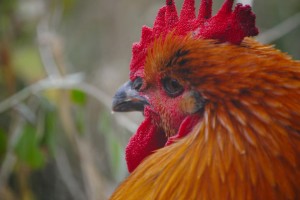Puzzled students clung to the south courtyard windows, looking at a sight they would expect to see on a farm, not a school. Three male chickens strutted around the school’s garden after being given this new home.
“It was so bizarre to hear that our school was having roosters,” Senior Zoe Berg exclaimed. “It was so random.”
Dean of Students Ed Collins, who takes care of the garden, originally put the birds in the courtyard in mid-November for weed control, but said the birds are useful in other ways as well. Collins said the chickens will control a weed called sandbur, which is resistant to any kind of weed killer and has wreaked a great deal of havoc in the garden. Collins had been debating on how to efficiently and successfully get rid of the species.
“We were going to bring in my daughter’s goats,” Collins mentioned, “but they’d get covered in burs.”
He decided upon using the chickens to feed on the invasive plant.
“Chickens will eat anything,” Collins said.
In addition to being a significant source of help for the unfortunate-looking garden, our feathered friends serve as entertainment.
“They’re fun to watch,” Collins stated. “They’re like an aquarium.”
The roosters were previously owned by Collins’ neighbor. When Collins was offered the birds, he didn’t have a use for them at home. Though he has a chicken coop at home, he wasn’t interested in roosters because they do not supply eggs. However, he could not say no.
“They were going to be someone’s Sunday dinner,” Collins, a vegetarian, commented.
The roosters have caught students off-guard and many are surprised to see the birds prancing about in the middle of the school.
“I was so shocked at the whole thing,” Berg said. “It was a school-wide ‘awe’ moment.”
Special Education Teacher Dave Gilbert has a class that cares for the low-maintenance birds by feeding them food from the school cafeteria and providing them with water.
“It’s a good lesson,” Gilbert said. “It teaches [them] some life skills.”
Gilbert’s class also built the hen house that the birds utilize while in the courtyard.
“We’re trying to give [my class] some fun experiences,” Gilbert stated. “[It shows them] how to take care of animals [and] how to work together.”
The roosters can live unsheltered in the garden year-round, surviving even the coldest winters.
“[My goal is] to get the garden cleaned-up, to have a nice home for the chickens, and to expose kids to farm animals,” Collins said. “It’s about sustainable living.”
To Collins, this project is not only about exterminating weeds. He believes students should know the basics of subsistence agriculture and environmentalism. By teaching students about raising chickens and the effects of invasive species, the next generation is better prepared to live greener lives. Also, Collins advocates for raising chickens because of its health factor.
“The [eggs] you get from the store are 45-60 days old,” Collins said.
In the future, Collins plans to finish landscaping the courtyard, plant food crops, and possibly begin building a compost pile.
Currently, there is a bit of unintentional sexism in the courtyard, but for good reason.
“If I were to add one hen out there, there would only be one rooster by the end of the day,” Collins explained. “If you ever want to see genetic imprinting at its finest, watch chickens. It’s all about preserving your own line at the expense of your competitor.”
Roosters, although small, are feisty creatures. Collins is not worried about the safety of the birds.
“Roosters are pretty tough predators,” Collins said. “If a hawk ever decided to go in there, he’d be gone.”
The three chickens are nameless, but Collins hopes to change that soon. He wants to organize a fundraiser with the help of Gilbert to establish names for the roosters and raise money for food and a water heater. The fundraiser would be Coin War style in which the students nominate names for the birds. Each bird would have jars for three possible names and the jars that win the coin war win the name.
One question remains: what will Collins do with the north courtyard? Well, he would like to have other animals displayed, perhaps rabbits. However, there might be difficulties.
“We don’t want to put two out there and end up with a hundred,” Collins said.
